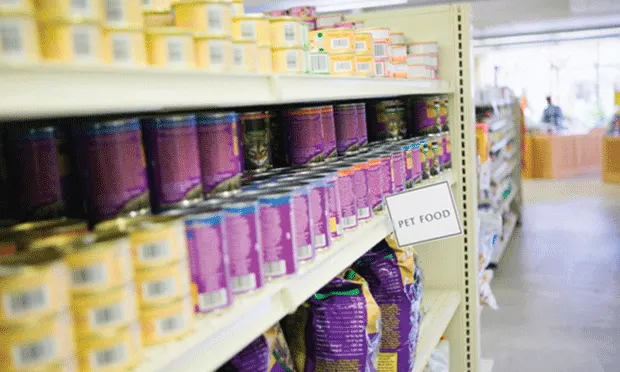Pet Food Regulation: Understanding AAFCO Guidelines

You have asked…How do I explain the importance of AAFCO to my clients?The expert says…
Understanding the role of the Association of American Feed Control Officials (AAFCO) in pet food regulation can help clients choose an appropriate diet for their pet.
Related Article: Homemade Diets
AAFCO, a nongovernmental advisory body that includes representatives from all states, provides detailed model feed laws that have been adopted by many states in full or as part of individual state feed control laws. The organization does not regulate, test, approve, or certify pet foods.
Pet food manufacturers are responsible for labeling, marketing, and formulating their products in compliance with local, state, and federal laws. In addition, feed control officials in each state are responsible for regulating pet foods to ensure compliance.
AAFCO guidelines include requirements for 8 specific features…
1. Brand and product name2. Species for which the product is intended3. Feeding instructions4. Manufacturer or distributor name and address5. Net quantity statement6. Guaranteed analysis7. Ingredient list8. Nutritional adequacy statement
…but pet owners may only read the guaranteed analysis, ingredient list, and nutritional adequacy statement.
Related Article: Polling Place: Compliance with Recommended Therapeutic Diets
Guaranteed Analysis
The guaranteed analysis (GA) provides minimum percentages for crude protein and fat and maximum percentages for moisture and crude fiber for dog and cat foods. In this context, crude refers to the laboratory method for determining the concentration (not quality) of the protein, fat, and fiber. Other nutrients are optional.
Of note, these numbers only represent minimum and maximum values, not the exact amounts of nutrients in the product.
Crude protein is the estimate of the total protein and is obtained by measuring the amount of nitrogen and multiplying by an average proportion of nitrogen in amino acids.
Crude fat is an estimate of the lipid content and is obtained through extraction of the food with ether. This procedure also isolates other compounds (eg, certain pigments, fat-soluble vitamins).
Crude fiber is the organic residue that remains after plant material has been treated with dilute acid and alkali solvents and after the mineral component has been subtracted. This measurement does not reflect all insoluble fiber present, and the procedure does not capture any soluble fiber. Crude fiber is not the equivalent to total dietary fiber, as reported in foods for humans.
The GA presents nutrient levels on an “as fed” basis, without accounting for the proportion of water or energy density of the product. This makes comparison of diets using GA values difficult without converting to a dry matter or energy basis; comparisons between canned and dry foods are not possible without conversion to a dry matter basis.
However, dry matter basis comparisons do not account for differences in fiber content. To more accurately compare foods differing in both water and fiber content, expressing nutrient concentrations on an energy basis is suggested (eg, grams of calcium/100 kcal).
In addition, the GA does not contain information about the digestibility or quality of the listed nutrients.

Ingredient List
The ingredient list is arranged in decreasing order of majority by weight. Ingredients must be listed by their common or usual name, and most have a corresponding definition in the AAFCO Official Publication.
Although the ingredient list can provide general information about the type of ingredients used in a pet food, descriptors of quality and grade are not permitted. Similar to the GA, the ingredient list is not presented on a dry matter or energy basis.
Related Article: Canine & Feline Nutrition Guidelines
In addition, it is impossible to tell which proportions of nutrients are coming from each ingredient, as the nutritional composition of each ingredient can vary and exact amounts are not disclosed.
Ingredient lists may not be particularly useful for practical nutritional information, and they do not contain information about the digestibility or quality of the diet.
Nutritional Adequacy Statement
Unless expressly labeled as snack or treat, a pet food is required by AAFCO to have a statement and validation of nutritional adequacy.
The product label will state that the pet food meets the requirements (ie, provides complete and balanced nutrition) of 1 or more recognized categories of nutritional adequacy:
Gestation and lactation
Growth
Maintenance
All life stages
Pet foods can be considered complete and balanced in 1 of 2 ways:
The manufacturer can prove by formulation (ie, calculations based on the composition of the ingredients and their inclusion levels in the product) that the product contains between the minimum and maximum required levels of all essential nutrients as established by the AAFCO dog or cat food nutrient profiles for specific life stages.
The manufacturer can show by feeding trials (as specified by AAFCO) that the product supports the specific life stage claimed on the package.
If neither claim can be made and the product is not explicitly labeled as snack or treat, then the label must state that the product is intended for supplemental or intermittent feeding only.
There is value to both methods of nutritional adequacy substantiation, but feeding trials (preferred by many nutritionists) can account for digestibility and bioavailability of nutrients.
Closing Thoughts
Ideally, diets are formulated to satisfy nutritional profiles and are subjected to feeding trials. Clients should ensure they are using a food with a nutritional adequacy statement matching the life stage of their pet.
JENNIFER LARSEN, DVM, MS, PhD, DACVN, is assistant professor of clinical nutrition at the Veterinary Medical Teaching Hospital at University of California, Davis, where she also earned her degrees and completed a residency in nutrition. Dr. Larsen is a clinical nutrition consultant and conducts research in clinical and basic nutrition. Her recent projects include analysis of fiber in pet foods, evaluation of homeprepared diets for pets, and assessment of nutritional status. Dr. Larsen frequently speaks at national conferences, as well as regional veterinary meetings.